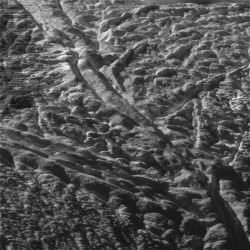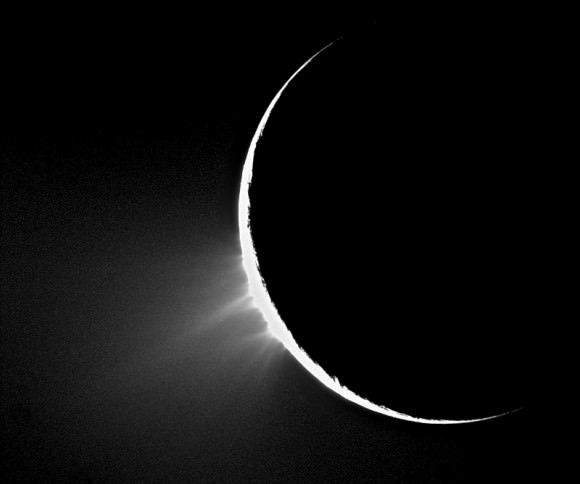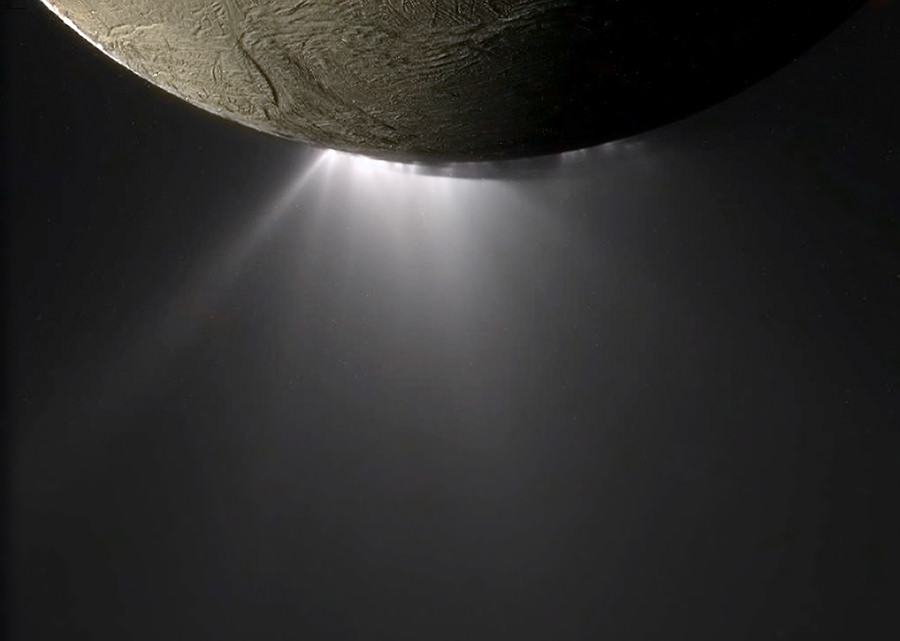Thanks to the Cassini mission we’ve known about the jets of icy brine spraying from the south pole of Saturn’s moon Enceladus for about 8 years now, but this week it was revealed at the 44th Lunar and Planetary Science Conference outside Houston, Texas that Enceladus’ jets very likely reach all the way down to the sea — a salty subsurface sea of liquid water that’s thought to lie beneath nearly 10 kilometers of ice.
Enceladus’ jets were first observed by the Cassini spacecraft in 2005. The jets constantly spray fine particles of ice into space which enter orbit around Saturn, creating the hazy, diffuse E ring in which Enceladus resides.
Emanating from deep fissures nicknamed “tiger stripes” that gouge the 512-km (318-mile) -wide moon’s south pole the icy jets — and the stripes — have been repeatedly investigated by Cassini, which has discovered that not only do the ice particles contain salts and organic compounds but also that the stripes are surprisingly warm, measuring at 180 Kelvin (minus 135 degrees Fahrenheit) — over twice as warm as most other regions of the moon.
Read more: Enceladus’ Salty Surprise
Where the jets are getting their supply of liquid water has been a question scientists have puzzled over for years. Is friction caused by tidal stresses heating the insides of the stripes, which melts the ice and shoots it upwards? Or do the fissures actually extend all the way down through Enceladus’ crust to a subsurface ocean of liquid water, and through tidal pressure pull vapor and ice up to the surface?

Researchers are now confident that the latter is the case.
In a presentation at the Lunar and Planetary Science Conference titled “How the Jets, Heat and Tidal Stresses across the South Polar Terrain of Enceladus Are Related” (see the PDF here) Cassini scientists note that the amount of heating due to tidal stress seen along Enceladus’ tiger stripes isn’t nearly enough to cause the full spectrum of heating observed, and the “hot spots” that have been seen don’t correlate with the type of heating caused by shear friction.
Instead, the researchers believe that heat energy is being carried upwards along with the pressurized water vapor from the subsurface sea, warming the areas around individual vents as well as serving to keep their channels open.
With 98 individual jets observed so far on Enceladus’ south polar terrain and surface heating corresponding to each one, this scenario, for lack of a better term… seems legit.
What this means is that not only does a moon of Saturn have a considerable subsurface ocean of liquid water with a heat source and Earthlike salinity (and also a bit of fizz) but also that it’s spraying that ocean, that potentially habitable environment, out into local space where it can be studied relatively easily — making Enceladus a very intriguing target for future exploration.
“To touch the jets of Enceladus is to touch the most accessible salty, organic-rich, extraterrestrial body of water and, hence, habitable zone, in our solar system.”
– Cassini imaging team leader Carolyn Porco et al.

Research notes via C. Porco, D. DiNino, F. Nimmo, CICLOPS, Space Science Institute at Boulder, CO, and Earth and Planetary Sciences at UC Santa Cruz, CA.
Top image: color-composite of Enceladus made from raw Cassini images acquired in 2010. The moon is lit by reflected light from Saturn while the jets are backlit by the Sun.


Lets go collect some, bring it back to earth in a capsule and hope it doesnt end up like the Andromeda Strain….
succesful lateral replication (like with Andromeda Strain) requires a bit of familiarity with human genetic code, and most often will just turn victims into jelly due to its succes rate of conversion.
“Just” getting turned into jelly seems bad enough!
A spaceprobe with a return capsule could be sent to Saturn. If the return capsule has an aerogel it could fly through the geysers. The samples could then be returned to Earth and analyzed for life.
LC
Yet the best NASA can do is to propose yet another been there done that mission to Mars repeating Curiosity instead of doing actual planetary discovery exploration to Europa, Enceladus, et. al. Not surprising as this is the same moribund agency that has had its manned space program spending 40 years going round and round in LEO AFTER landing on the moon. Pathetic.
As if we were ‘finished’ with Mars, or even the Moon…
Stand in line with those who are dying to get something to Europa, or back to Titan. Sorry, but with existing technology, the solar system is bigger than our ability to chase after every tantalizing object/phenomena in it at once.
Yesterday on the ‘boob tube’ I watched a show about Curiosity’s development. Turns out that TWO rovers were built… one for Mars and one for mission sims and trouble shooting. Why not send the 2nd rover to Mars or the Moon or even Enceladus?
It’s 3 such rovers, but the sim is not complete. The 2nd was always intended for Mars and will go 2020 IIRC.
Mars is a consistent, promising target for habitability surveys. And now we know it was habitable, so we want to look for fossils next.
Enceladus and Europa are way down in priority as regards astrobiology.
And, manned missions? Neither relevant here, nor a failure. (ISS, commercials, developing BEO manned technology et cetera.)
How much fuel does cassini have left? Can she orbit close in, get a good soaking and then limp back towards Earth? Yes we can…I think.
Sure. Just land on Iapetus, pick up some new dilithium
crystals, and engage the warp drive.
But first, tell mommy your sippy cup fell on the floor.
Several problems with this.
Cassini is gravitational bound to Saturn now. Not enough fuel to escape orbit. Also, how would it drop off its payload at Earth assuming it could even collect it? The orbiter wasn’t designed for capturing particles. Cassini would also be flying too fast and does not have enough fuel to slow down to enter Earth orbit for a rendezvous if it could make its way back to the inner solar system.
Believe current plans call for Cassini doing a controlled deorbit into Saturn around 2016 or so when its fuel runs out.
Gotta get some samples!
The plot thickens and the ice thins. Right after Europa has been declared containing Earth like chlorine salt water and have communication between the ocean and the ice surface, Enceladus hits back with open hole communication and “salty” organic rich waters.
If the sodium and potassium salts of Enceladus is chlorine based, it makes a more immediately rewarding target than Europa. However, I’m still concerned that the detected organics are primordial “comet” like instead of metabolites. If there are no melt water pockets venting ice constituents, the promise of the ocean goes down in my (layman) opinion.